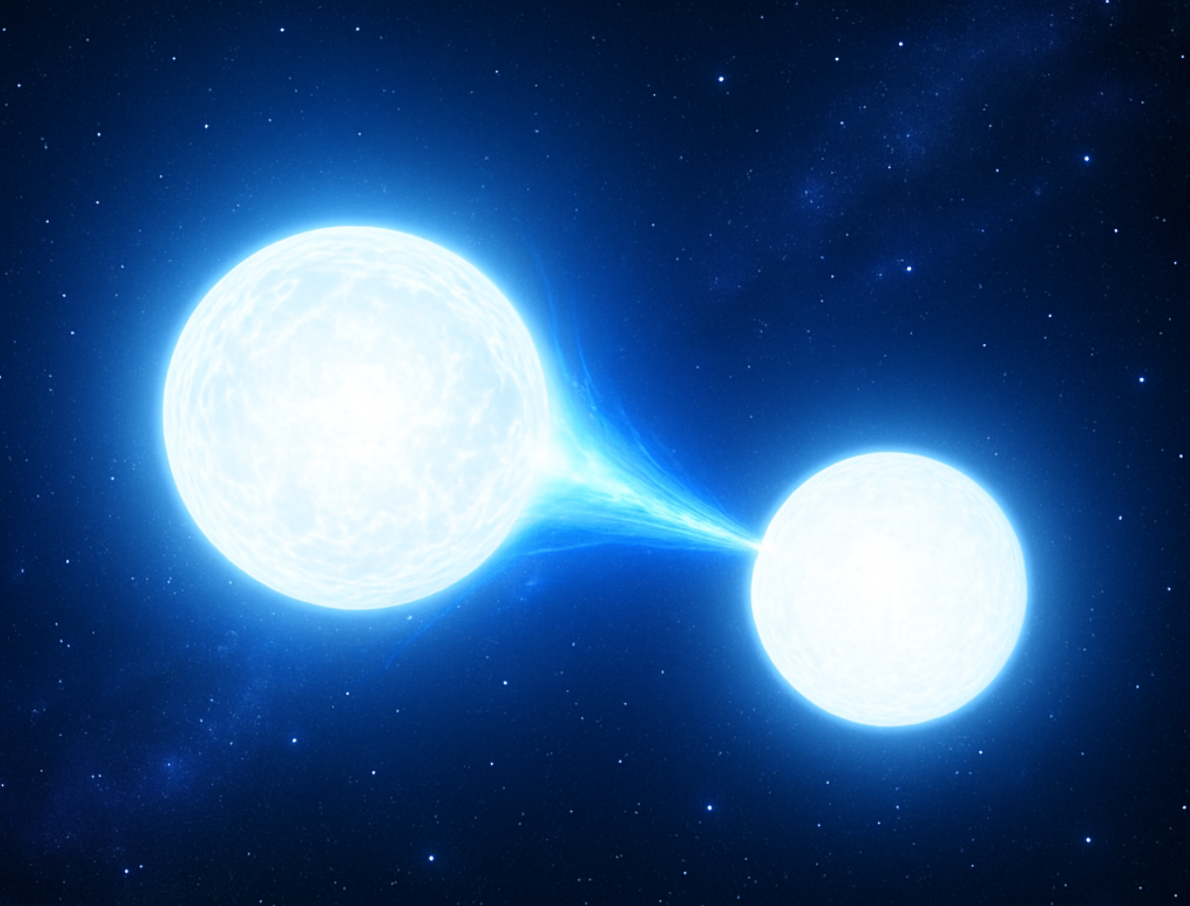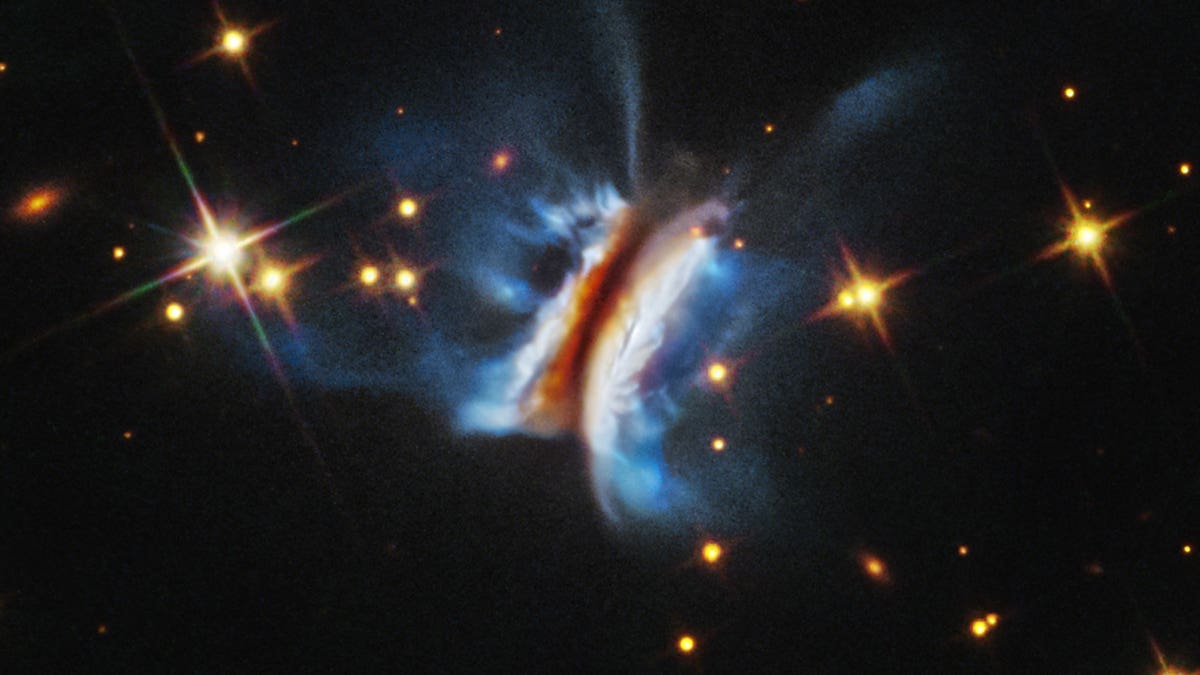Rare white dwarf star collision revealed by Hubble Telescope
Hubble’s ultraviolet detection of trace carbon in white dwarf star WD 0525+526 shows a rare white dwarf merger event.

Hubble’s ultraviolet detection of trace carbon shows a rare white dwarf merger event. (CREDIT: AI-Generated / The Brighter Side of News)
A rare white dwarf merger remnant emerges in ultraviolet light, revealing thin layers of hydrogen and helium stripped away during a cosmic collision.
Scientists at the University of Warwick report the ultraviolet detection of carbon in WD 0525+526. This ultra‑massive white dwarf, located about 130 light‑years away, carries evidence of a rare white dwarf merger. With 20 percent more mass than the Sun, WD 0525+526 stands out among common stellar remnants.
In optical light, it looks like an ordinary hydrogen‑rich white dwarf. Ultraviolet spectra from the Hubble Space Telescope exposed faint carbon in its atmosphere. This small carbon trace marks this object as a product of a rare white dwarf merger rather than single‑star evolution.
In a paper published in Nature Astronomy, Snehalata Sahu (University of Warwick) and Antoine Bédard (Warwick Prize Fellow) present ultraviolet data showing carbon at log(C/H) = –4.62. The detected carbon is 4–5 orders of magnitude lower than previously known merger remnants. Such low carbon makes this the earliest‑stage example of a rare white dwarf merger found so far.
Early Ultraviolet Revelations
Ultra‑massive white dwarfs normally hide carbon beneath thick hydrogen and helium envelopes. In WD 0525+526 those layers are ten‑billion times thinner. That thinning likely resulted from two stars merging and burning off outer layers during the collision. This rare white dwarf merger left a stripped remnant with a nearly pure hydrogen atmosphere yet with carbon leaking through.
At nearly four times the Sun’s surface temperature, WD 0525+526 is too hot for convection to bring carbon up. Instead, the team identified semi‑convection—a subtle mixing process that allows modest carbon to drift upward. This mechanism had not been seen before in white dwarfs and marks a new chapter in stellar physics.
Related Stories
- White dwarf duo reveals the origins of the universe’s brightest explosions
- White dwarf stars could host life-supporting planets, study finds
- 4,000 white dwarf star explosions revolutionize dark energy research
Unraveling the Merger Story
The team used HST Cosmic Origin Spectrograph data to detect C ii and C iii lines. These far‑UV transitions only appear in space‑based spectra because Earth’s atmosphere blocks such wavelengths. Optical studies had missed carbon entirely. Sahu explained that ultraviolet light was key to revealing this hidden signature. Professor Boris Gänsicke (Warwick) emphasized that ultraviolet spectroscopy identifies merger signs invisible at optical wavelengths.
Modeling of WD 0525+526’s envelope shows a hydrogen‑rich layer about 10^–13.8 of total mass, and helium layer about 10^–12.6—far smaller than typical single‑star white dwarfs. These tiny layers let carbon from the core reach the surface through semi‑convective mixing. The envelope structure, combined with the low carbon abundance, fits only a rare white dwarf merger origin.
Significance for Binary Star Evolution
Ultra‑massive white dwarfs are linked to the Q‑branch in the Gaia Hertzsprung–Russell diagram. That branch shows cooling delays up to one billion years from core crystallization and element distillation. Some of these stars may arise from mergers of white dwarfs and subgiant stars. But attributing this origin to specific objects has proven difficult.
WD 0525+526 now provides clear evidence. It lies on the Q‑branch, with mass around 1.20 M⊙ and effective temperature 20,820 K. Its carbon abundance at log(C/H)=–4.62 and thin envelopes indicate merger origin. This single case confirms that some Q‑branch members are remnants of rare white dwarf merger events.
Understanding these mergers helps explain binary star fates and potential progenitors of thermonuclear supernovae. The six known DAQ type white dwarfs exhibit log(C/H) > –0.5 and appear in optical spectra. WD 0525+526 shows how many merger remnants may hide beneath pure hydrogen layers, detectable only in ultraviolet. This suggests that atmospheric carbon pollution among hot ultra‑massive hydrogen‑rich white dwarfs may be more common than thought.
Future Discovery Potential
WD 0525+526 is the nearest and hottest DAQ white dwarf known. Its carbon signature would remain unseen without Hubble’s sensitive ultraviolet capability. As WD 0525+526 cools over time, convection may bring more carbon to the surface, revealing more merger remnants at later stages.
Hubble, now 35 years old, is still the only telescope able to perform such observations. Researchers stress planning for a new ultraviolet observatory to continue this work. That future instrument would allow systematic survey of ultra‑massive white dwarfs and reveal the hidden population of rare white dwarf merger remnants across the galaxy.
Implications and Insights
This discovery extends knowledge of how binary star systems end. It shows that a rare white dwarf merger can strip outer layers and expose carbon early through semi‑convection. That process is now confirmed by nature. The finding also implies many ultra‑massive white dwarfs may be merger relics in disguise.
It challenges assumptions that hydrogen‑rich white dwarfs lack carbon. Instead, low‑level carbon may lurk beneath thin atmospheres. Detecting it requires ultraviolet data.
This research deepens understanding of Q‑branch cooling delays, binary merger rates, and possible progenitors of Type Ia supernovae. WD 0525+526 offers a benchmark for models of stellar mergers and white dwarf evolution.
Past Studies and Findings
Previous optical surveys had identified six ultra-massive DAQ white dwarfs, each containing carbon abundances with log(C/H) greater than –0.5. These stars have masses ranging between 1.13 and 1.19 solar masses and temperatures from 13,000 to 17,000 Kelvin.
Researchers attributed the presence of carbon in their atmospheres to convective mixing, suggesting origins from merger events. Analyses from the Gaia mission later revealed the Q-branch in the white dwarf cooling sequence, connecting delayed cooling periods of ultra-massive stars with core crystallization.
Scientists believe mergers could explain these cooling delays. Additionally, theoretical models, such as those developed by Bédard and Cunningham, have extensively studied diffusion and convective mixing in white dwarf envelopes.
Their work indicated that thin hydrogen-helium layers would enable semi-convection, which might transport carbon from the stellar interior to the surface. However, these past studies lacked direct ultraviolet observations needed to detect lower carbon levels in the hottest DAQ white dwarfs.
The recent research by Snehalata Sahu and her colleagues, using the Hubble Space Telescope, has now provided this crucial ultraviolet detection, confirming the presence of faint carbon signatures and shedding new light on these rare white dwarf merger remnants.
Gateway to the Future:
This rare white dwarf merger discovery opens new ways to identify merger remnants. Future space telescopes with ultraviolet sensitivity can survey many more ultra‑massive white dwarfs. That will refine binary merger rates, improve models of Type Ia supernova progenitors, and trace stellar evolution pathways.
Greater knowledge of semi‑convection may apply to other hot stars. Ultimately, understanding these processes benefits astrophysics and cosmic chronometry, refining our cosmic history tools.
What We’ve Learned:
- WD 0525+526’s ultraviolet carbon signals confirm it as a rare white dwarf merger remnant.
- Semi‑convection supports carbon transport in hot, hydrogen‑layer‑stripped white dwarfs.
- Many ultra‑massive hydrogen‑rich white dwarfs may hide carbon pollution, revealed only in ultraviolet.
Note: The article above provided above by The Brighter Side of News.
Like these kind of feel good stories? Get The Brighter Side of News' newsletter.



